2024 |
||
| 13. | 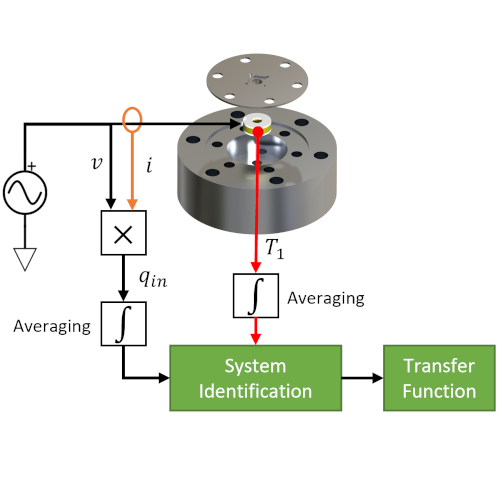 | Y. K. Yong; A. A. Eielsen; A. J. Fleming Thermal Protection of Piezoelectric Actuators Using Complex Electrical Power Measurements and Simplified Thermal Models Journal Article Forthcoming In: IEEE/ASME Transactions on Mechatronics, Forthcoming, ISBN: 1083-4435. Abstract | Links | BibTeX | Tags: piezoelectric, System Identification, Thermal @article{J24b,This article describes a method for estimating the temperature of high-power piezoelectric actuators when a direct temperature measurement is impractical. The heat flow is estimated from the real component of the electrical power; then, the temperature is estimated by a transfer function that approximates the thermal response of the system. The transfer function can be derived analytically from a lumped-element approximation or calibrated experimentally by using a system identification method. The proposed method is demonstrated on a piezoelectric stack actuator used in a high-speed nanopositioning device. A second-order transfer function estimates the temperature to within 3 ∘ C of a reference measurement for a range of operating conditions. The proposed method is suitable for protecting piezoelectric actuators in applications where direct temperature measurement is impractical, for example, due to space or wiring constraints. |
2020 |
||
| 12. | 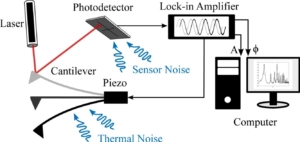 | M. G. Ruppert; N. J. Bartlett; Y. K. Yong; A. J. Fleming Amplitude Noise Spectrum of a Lock-in Amplifier: Application to Microcantilever Noise Measurements Journal Article In: Sensors and Actuators A: Physical, vol. 312, pp. 112092, 2020, (This work was supported by the Australian Research Council Discovery Project DP170101813). Abstract | Links | BibTeX | Tags: AFM, Cantilever, Demodulation, DP170101813, MEMS, System Identification @article{Ruppert2020,The lock-in amplifier is a crucial component in many applications requiring high-resolution displacement sensing; it's purpose is to estimate the amplitude and phase of a periodic signal, potentially corrupted by noise, at a frequency determined by a reference signal. Where the noise can be approximated by a stationary Gaussian process, such as thermal force noise and electronic sensor noise, this article derives the amplitude noise spectral density of the lock-in-amplifier output. The proposed method is demonstrated by predicting the demodulated noise spectrum of a microcantilever for dynamic-mode atomic force microscopy to determine the cantilever on-resonance thermal noise, the cantilever tracking bandwidth and the electronic noise floor. The estimates are shown to closely match experimental results over a wide range of operating conditions. |
2019 |
||
| 11. | 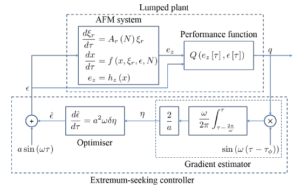 | K. Wang; M. G. Ruppert; C. Manzie; D. Nesic; Y. K. Yong Adaptive Scan for Atomic Force Microscopy Based on Online Optimisation: Theory and Experiment Journal Article In: IEEE Transactions on Control System Technology, 2019, (accepted for publication). Abstract | Links | BibTeX | Tags: AFM, Nanopositioning, SPM, System Identification, Tracking Control @article{Wang2019,A major challenge in Atomic Force Microscopy (AFM) is to reduce the scan duration while retaining the image quality. Conventionally, the scan rate is restricted to a sufficiently small value in order to ensure a desirable image quality as well as a safe tip-sample contact force. This usually results in a conservative scan rate for samples that have a large variation in aspect ratio and/or for scan patterns that have a varying linear velocity. In this paper, an adaptive scan scheme is proposed to alleviate this problem. A scan line-based performance metric balancing both imaging speed and accuracy is proposed, and the scan rate is adapted such that the metric is optimised online in the presence of aspect ratio and/or linear velocity variations. The online optimisation is achieved using an extremum-seeking (ES) approach, and a semi-global practical asymptotic stability (SGPAS) result is shown for the overall system. Finally, the proposed scheme is demonstrated via both simulation and experiment. |
2018 |
||
| 10. |  | S. I. Moore; M. G. Ruppert; Y. K. Yong Arbitrary placement of AFM cantilever higher eigenmodes using structural optimization Proceedings Article In: International Conference on Manipulation, Automation and Robotics at Small Scales (MARSS), 2018, (This work was supported by the Australian Research Council Discovery Project DP170101813). Abstract | BibTeX | Tags: AFM, Cantilever, DP170101813, MEMS, Multifrequency AFM, Piezoelectric Transducers and Drives, Sensors, SPM, System Identification @inproceedings{Moore2018,This article presents a novel cantilever design approach to place higher mode frequencies within a specific frequency band to alleviate instrumentation and Q control feasibility. This work is motivated by the emerging field of multifrequency atomic force microscopy (AFM) which involves the excitation and/or detection of several cantilever modes at once. Unlike other operating modes, multifrequency AFM allows the tracking of the sample topography on the fundamental mode while simultaneously acquiring complimentary nanomechanical information on a higher mode. However, higher modes of conventional rectangular tapping-mode cantilevers are usually in the MHz regime and therefore impose severe restrictions on the direct controllability of these modes. To overcome this limitation, an optimization technique is employed which is capable of placing the first five modes within a 200 kHz bandwidth. |
| 9. |  | M. G. Ruppert Self-sensing, estimation and control in multifrequency Atomic Force Microscopy. Journal Article In: Journal & Proceedings of the Royal Society of New South Wales, vol. 151, no. 1, pp. 111, 2018, ISSN: 0035-9173/18/010111-01. Abstract | Links | BibTeX | Tags: Cantilever, MEMS, Multifrequency AFM, Sensors, Smart Structures, SPM, System Identification, Vibration Control @article{Ruppert2018b,Despite the undeniable success of the atomic force microscope (AFM), dynamic techniques still face limitations in terms of spatial resolution, imaging speed and high cost of acquisition. In order to expand the capabilities of the instrument, it was realized that the information about the nano-mechanical properties of a sample are encoded over a range of frequencies and the excitation and detection of higher-order eigenmodes of the micro-cantilever open up further informa- tion channels. The ability to control these modes and their fast responses to excitation is believed to be the key to unravelling the true potential of these ethods. This work addresses three major drawbacks of the standard AFM setup, which limit the feasibility of multi-frequency approaches. First, microelectromechanical system (MEMS) probes with integrated piezoelectric layers is motivated, enabling the development of novel multimode self-sensing and self-actuating techniques. Specifically, these piezoelectric transduction schemes permit the miniaturization of the entire AFM towards a cost-effective single-chip device with nanoscale precision in a much smaller form factor than that of conventional macroscale instruments. Second, the integrated actuation enables the development of multimode controllers which exhibits remarkable performance in arbitrarily modifying the quality factor of multiple eigenmodes and comes with inherent stability robustness. The experimental results demonstrate improved imaging stability, higher scan speeds and adjustable contrast when mapping nano-mechanical properties of soft samples. Last, in light of the demand for constantly increasing imaging speeds while providing multi-frequency flexibility, the estimation of multiple components of the high-frequency deflection signal is performed with a linear time-varying multi-frequency Kalman filter. The chosen representation allows for an efficient high-bandwidth implementation on a Field Programmable Gate Array. Tracking bandwidth, noise performance and trimodal AFM imaging on a two-component polymer sample are verified and shown to be superior to that of the commonly used lock-in amplifier. |
2017 |
||
| 8. | 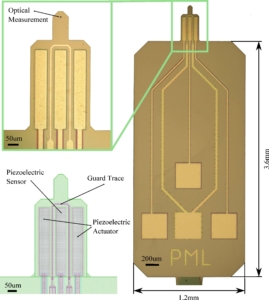 | M. G. Ruppert; Y. K. Yong Note: Guaranteed collocated multimode control of an atomic force microscope cantilever using on-chip piezoelectric actuation and sensing Journal Article In: Review of Scientific Instruments, vol. 88, no. 086109, 2017, (This work was supported by the Australian Research Council Discovery Project DP170101813). Abstract | Links | BibTeX | Tags: AFM, Cantilever, DP170101813, MEMS, Multifrequency AFM, Piezoelectric Transducers and Drives, System Identification, Vibration Control @article{Ruppert2017b,The quality (Q) factor is an important parameter of the resonance of the microcantilever as it determines both imaging bandwidth and force sensitivity. The ability to control the Q factor of multiple modes is believed to be of great benefit for atomic force microscopy techniques involving multiple eigenmodes. In this paper, we propose a novel cantilever design employing multiple piezoelectric transducers which are used for separated actuation and sensing, leading to guaranteed collocation of the first eight eigenmodes up to 3 MHz. The design minimizes the feedthrough usually observed with these systems by incorporating a guard trace on the cantilever chip. As a result, a multimode Q controller is demonstrated to be able to modify the quality factor of the first two eigenmodes over up to four orders of magnitude without sacrificing robust stability. |
2016 |
||
| 7. | 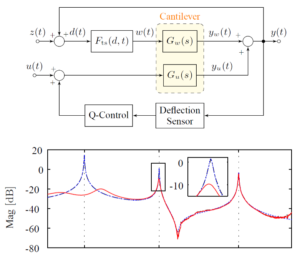 | M. G. Ruppert; S. O. R. Moheimani Multimode Q Control in Tapping-Mode AFM: Enabling Imaging on Higher Flexural Eigenmodes Journal Article In: IEEE Transactions on Control Systems Technology, vol. 24, no. 4, pp. 1149-1159, 2016. Abstract | Links | BibTeX | Tags: MEMS, Multifrequency AFM, SPM, System Identification, Vibration Control @article{Ruppert2016b,Numerous dynamic Atomic Force Microscopy (AFM) methods have appeared in recent years, which make use of the excitation and detection of higher order eigenmodes of the microcantilever. The ability to control these modes and their responses to excitation is believed to be the key to unraveling the true potential of these methods. In this work, we highlight a multi-mode Q control method that exhibits remarkable damping performance and stability robustness. The experimental results obtained in ambient conditions demonstrate improved imaging stability by damping non-driven resonant modes when scanning is performed at a higher eigenmode of the cantilever. Higher scan speeds are shown to result from a decrease in transient response time. |
2014 |
||
| 6. |  | K. S. Karvinen; M. G. Ruppert; K. Mahata; S. O. R. Moheimani Direct Tip-Sample Force Estimation for High-Speed Dynamic Mode Atomic Force Microscopy Journal Article In: IEEE Transactions on Nanotechnology, vol. 13, no. 6, pp. 1257-1265, 2014. Abstract | Links | BibTeX | Tags: SPM, System Identification @article{Karvinen2014,We present new insights into the modeling of the microcantilever in dynamic mode atomic force microscopy and outline a novel high-bandwidth tip-sample force estimation technique for the development of high-bandwidth z-axis control. Fundamental to the proposed technique is the assumption that in tapping mode atomic force microscopy, the tip-sample force takes the form of an impulse train. Formulating the estimation problem as a Kalman filter, the tip-sample force is estimated directly; thus, potentially enabling high-bandwidth z-axis control by eliminating the dependence of the control technique on microcantilever dynamics and the amplitude demodulation technique. Application of this technique requires accurate knowledge of the models of the microcantilever; a novel identification method is proposed. Experimental data are used in an offline analysis for verification. |
2013 |
||
| 5. | 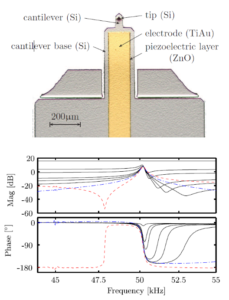 | M. G. Ruppert; S. O. R. Moheimani A novel self-sensing technique for tapping-mode atomic force microscopy Journal Article In: Review of Scientific Instruments, vol. 84, no. 12, pp. 125006, 2013. Abstract | Links | BibTeX | Tags: MEMS, Smart Structures, SPM, System Identification @article{Ruppert2013b,This work proposes a novel self-sensing tapping-mode atomic force microscopy operation utilizing charge measurement. A microcantilever coated with a single piezoelectric layer is simultaneously used for actuation and deflection sensing. The cantilever can be batch fabricated with existing Micro Electro Mechanical System processes. The setup enables the omission of the optical beam deflection technique which is commonly used to measure the cantilever oscillation amplitude. Due to the high amount of capacitive feedthrough in the measured charge signal, a feedforward control technique is employed to increase the dynamic range from less than 1dB to approximately 35dB. Experiments show that the conditioned charge signal achieves excellent signal-to-noise ratio and can therefore be used as a feedback signal for AFM imaging. |
2003 |
||
| 4. | A. J. Fleming; S. O. R. Moheimani Spatial system identification of a simply supported beam and a trapezoidal cantilever plate Proceedings Article In: Proc. IEEE Conference on Decision and Control, Las Vegas, NV, 2003. Links | BibTeX | Tags: System Identification @inproceedings{C02c, | |
| 3. | A. J. Fleming; S. O. R. Moheimani Spatial system identification of a simply supported beam and a trapezoidal cantilever plate Journal Article In: IEEE Transactions on Control Systems Technology, vol. 11, no. 5, pp. 726–736, 2003. Links | BibTeX | Tags: System Identification @article{J03e, | |
2002 |
||
| 2. | T. McKelvey; A. J. Fleming; S. O. R. Moheimani Subspace-based system identification for an acoustic enclosure Journal Article In: Transactions of the ASME, Journal of Vibration & Acoustics, vol. 124, no. 3, pp. 414–419, 2002. Links | BibTeX | Tags: System Identification @article{J02b, | |
2000 |
||
| 1. | T. McKelvey; A. J. Fleming; S. O. R. Moheimani Subspace based system identification for an acoustic enclosure Proceedings Article In: Proc. IEEE International Conference on Control Applications & IEEE International Symposium on Computer-Aided Control Systems Design, Anchorage, Alaska, 2000. Links | BibTeX | Tags: System Identification @inproceedings{C00a, | |
2024 |
||
| 13. |  | Thermal Protection of Piezoelectric Actuators Using Complex Electrical Power Measurements and Simplified Thermal Models Journal Article Forthcoming In: IEEE/ASME Transactions on Mechatronics, Forthcoming, ISBN: 1083-4435. |
2020 |
||
| 12. |  | Amplitude Noise Spectrum of a Lock-in Amplifier: Application to Microcantilever Noise Measurements Journal Article In: Sensors and Actuators A: Physical, vol. 312, pp. 112092, 2020, (This work was supported by the Australian Research Council Discovery Project DP170101813). |
2019 |
||
| 11. |  | Adaptive Scan for Atomic Force Microscopy Based on Online Optimisation: Theory and Experiment Journal Article In: IEEE Transactions on Control System Technology, 2019, (accepted for publication). |
2018 |
||
| 10. |  | Arbitrary placement of AFM cantilever higher eigenmodes using structural optimization Proceedings Article In: International Conference on Manipulation, Automation and Robotics at Small Scales (MARSS), 2018, (This work was supported by the Australian Research Council Discovery Project DP170101813). |
| 9. |  | Self-sensing, estimation and control in multifrequency Atomic Force Microscopy. Journal Article In: Journal & Proceedings of the Royal Society of New South Wales, vol. 151, no. 1, pp. 111, 2018, ISSN: 0035-9173/18/010111-01. |
2017 |
||
| 8. |  | Note: Guaranteed collocated multimode control of an atomic force microscope cantilever using on-chip piezoelectric actuation and sensing Journal Article In: Review of Scientific Instruments, vol. 88, no. 086109, 2017, (This work was supported by the Australian Research Council Discovery Project DP170101813). |
2016 |
||
| 7. |  | Multimode Q Control in Tapping-Mode AFM: Enabling Imaging on Higher Flexural Eigenmodes Journal Article In: IEEE Transactions on Control Systems Technology, vol. 24, no. 4, pp. 1149-1159, 2016. |
2014 |
||
| 6. |  | Direct Tip-Sample Force Estimation for High-Speed Dynamic Mode Atomic Force Microscopy Journal Article In: IEEE Transactions on Nanotechnology, vol. 13, no. 6, pp. 1257-1265, 2014. |
2013 |
||
| 5. |  | A novel self-sensing technique for tapping-mode atomic force microscopy Journal Article In: Review of Scientific Instruments, vol. 84, no. 12, pp. 125006, 2013. |
2003 |
||
| 4. | Spatial system identification of a simply supported beam and a trapezoidal cantilever plate Proceedings Article In: Proc. IEEE Conference on Decision and Control, Las Vegas, NV, 2003. | |
| 3. | Spatial system identification of a simply supported beam and a trapezoidal cantilever plate Journal Article In: IEEE Transactions on Control Systems Technology, vol. 11, no. 5, pp. 726–736, 2003. | |
2002 |
||
| 2. | Subspace-based system identification for an acoustic enclosure Journal Article In: Transactions of the ASME, Journal of Vibration & Acoustics, vol. 124, no. 3, pp. 414–419, 2002. | |
2000 |
||
| 1. | Subspace based system identification for an acoustic enclosure Proceedings Article In: Proc. IEEE International Conference on Control Applications & IEEE International Symposium on Computer-Aided Control Systems Design, Anchorage, Alaska, 2000. | |
